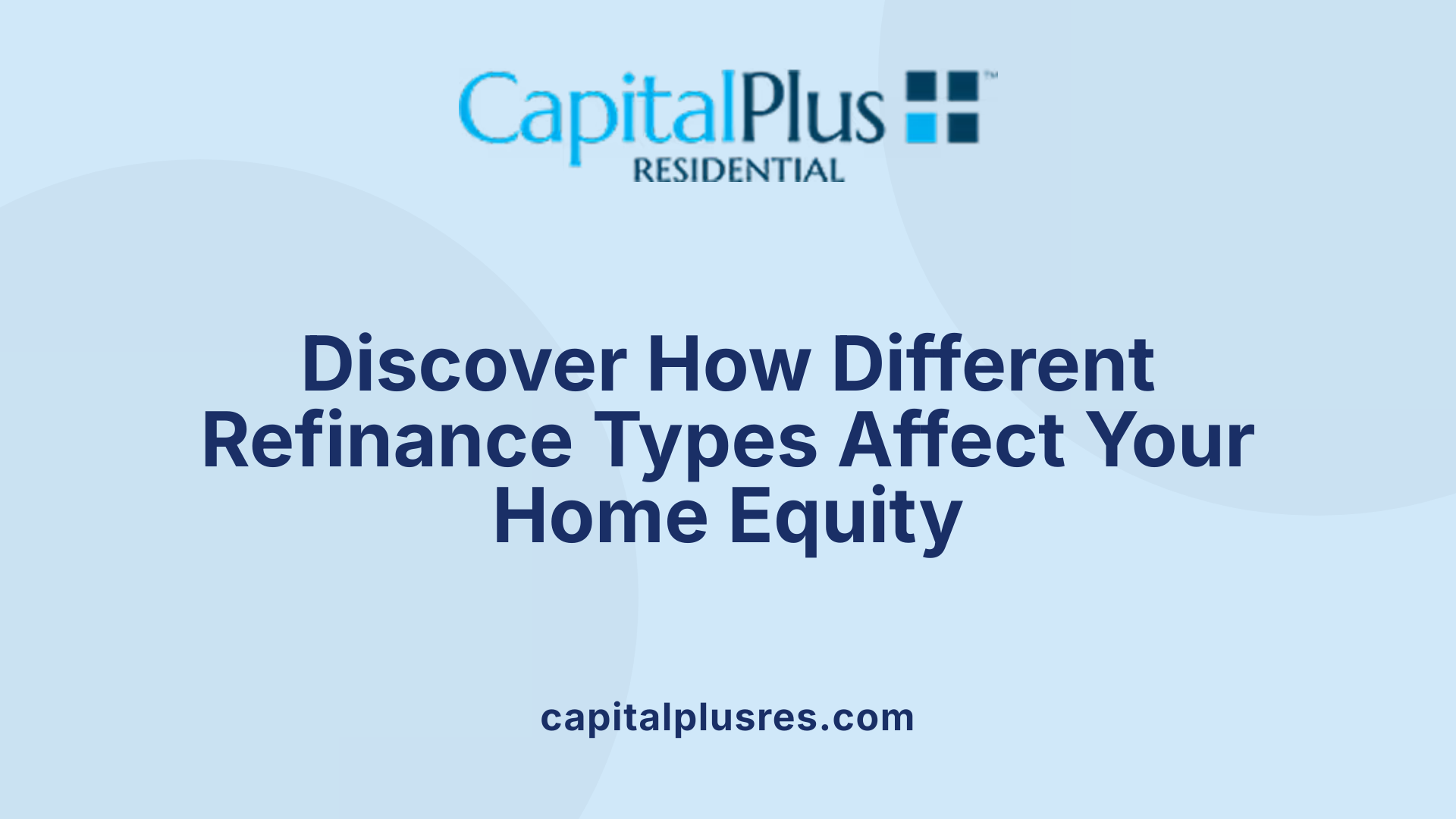Understanding Home Equity's Influence on Refinancing Eligibility
Home equity is a homeowner's stake in their property—the difference between its current market value and the outstanding mortgage balance. It serves as a cornerstone in determining refinancing eligibility, impacting both the cost and availability of refinancing options. This article explores how home equity affects refinancing decisions, the types of refinancing available, and strategies homeowners can use to optimize their equity position to achieve financial goals.
What Is Home Equity and How Is It Calculated?

Definition of Home Equity
Home equity represents the portion of a home's market value that the homeowner truly owns free and clear of any mortgage debt. Simply put, it's the current market value of the property minus the remaining balance on any mortgages or liens.
Calculation Formula for Home Equity
To calculate home equity as a percentage, use this formula:
Home Equity % = (Paid Off Amount / Current Home Value) × 100
This reveals how much of the home's value is owned outright.
Relationship Between Home Value, Mortgage Balance, and Equity
The home's market value and mortgage balance are the two main components determining equity. If the home value increases or the mortgage balance decreases through payments, equity grows. Conversely, if market values drop or borrowing increases, equity diminishes.
Loan-to-Value Ratio (LTV) and Its Significance
The loan-to-value (LTV) ratio measures the amount owed compared to the home's value:
LTV = Outstanding Mortgage Balance / Home Market Value
A lower LTV indicates higher home equity. Lenders prefer an LTV of 80% or less because it reduces their risk. Higher equity (lower LTV) can lead to better refinancing options, including lower interest rates and potentially removal of mortgage insurance.
Understanding your home equity and LTV is essential when considering refinancing, buying, or leveraging your property for financial goals.
Types of Refinancing and Their Impact on Home Equity

How do different types of refinancing affect home equity?
Refinancing your mortgage can influence your home's equity, but the effect largely depends on the type of refinance you choose.
Rate-and-term refinancing generally has minimal impact on your home equity. This type replaces your existing mortgage with a new loan of a similar amount, without borrowing extra funds from your home's value. As a result, your ownership stake typically remains unchanged unless the appraisal shows significant value changes. This option often helps by adjusting interest rates or loan terms without altering equity.
On the other hand, cash-out refinancing reduces your home equity because it allows you to borrow additional money against your property. The new loan amount exceeds your previous mortgage, which means your mortgage balance increases. This lowers the portion of the home you actually own.
Additionally, many homeowners choose to roll closing costs into their new loan during refinancing. While this can ease upfront expenses, it increases your total mortgage balance. Consequently, it reduces your home equity since the amount owed rises without a corresponding increase in property value.
Understanding these impacts can help homeowners make informed refinancing decisions that align with their financial goals and protect their equity.
| Refinancing Type | Effect on Home Equity | Explanation |
|---|---|---|
| Rate-and-term refinance | Usually maintains or slightly changes | Replaces mortgage with similar loan amount |
| Cash-out refinance | Decreases equity | Borrowing additional funds increases loan balance |
| Rolling closing costs | Decreases equity | Adds costs to mortgage, raising total balance |
Minimum Home Equity Requirements for Refinancing

What home equity levels do lenders require for refinancing?
Lenders generally set minimum home equity thresholds to qualify for refinancing, which vary by loan type. For conventional loans, most lenders require at least 20% equity. This threshold helps borrowers avoid private mortgage insurance (PMI), a cost added when equity falls below 20%. However, refinancing can be done with as little as 5-10% equity, though PMI payments will typically be necessary in those cases.
Government-backed loans have more flexible equity requirements. FHA loans allow refinancing with as low as 3.5% home equity but mandate mortgage insurance for the duration of the loan. VA loans, specifically through the Interest Rate Reduction Refinance Loan (IRRRL) program, often have no minimum equity requirement for rate-and-term refinancing. For cash-out refinances, VA loans generally require about 10% equity. USDA loans usually have minimal equity requirements for refinancing but do not permit cash-out refinancing unless switching to a conventional loan.
Specialized refinance programs offer options for borrowers with low or even negative equity. For example, FHA Streamline and VA IRRRL programs often allow refinancing without a home appraisal and without minimum equity requirements, making them viable solutions for those underwater on their mortgages.
Private Mortgage Insurance (PMI) considerations
Borrowers with less than 20% equity on conventional loans commonly face PMI requirements, which increase monthly payments. Achieving 20% equity can lead to PMI removal, reducing costs. On FHA loans, mortgage insurance is required regardless of equity level but differs in cost structure.
Understanding these minimum equity requirements allows homeowners to identify refinancing options best suited to their financial situations.
| Loan Type | Minimum Equity Required | PMI / Insurance Considerations |
|---|---|---|
| Conventional | Typically 20%; as low as 5-10% possible | PMI required if below 20% equity |
| FHA | As low as 3.5% | Mortgage insurance required for life of loan |
| VA (IRRRL program) | None for rate-and-term; ~10% for cash-out | No PMI; funding fee may apply |
| USDA | Minimal for refinance; no cash-out | Mortgage insurance required |
| Specialized Programs | Low or negative equity accepted | Often no appraisal or equity requirements |
Role of Home Appraisal and Market Value in Equity and Refinancing

Importance of appraisal in determining current home value
A home appraisal is an expert assessment of a property's current market value. This appraisal is fundamental in calculating home equity—the difference between the home's market value and the remaining mortgage balance. Accurate appraisals help both homeowners and lenders understand the true value of the property when considering refinancing options.
Impact of appraisal results on equity
If an appraisal reports a higher market value than expected, homeowners may see an increase in their home equity. This positive shift can open doors to better refinancing terms, such as lower interest rates or opportunities to remove private mortgage insurance. On the other hand, a lower appraisal value reduces home equity, potentially limiting refinancing eligibility or increasing loan costs.
Influence of market fluctuations on home value and equity
Home equity is also influenced by broader real estate market trends. When property values rise due to favorable market conditions, equity typically grows. Conversely, market downturns can decrease a home's value, sometimes pushing the mortgage balance above the home's worth, a situation known as being "underwater." This reduces equity and restricts refinancing possibilities, while increasing lender risk.
Homeowners should keep in mind that market fluctuations can impact refinancing timing and success. Regularly monitoring property values and obtaining updated appraisals when refinancing are prudent steps to ensure optimal loan terms and financial benefits.
How Home Equity Influences Refinancing Terms and Benefits
In what ways does home equity affect refinancing terms and borrower benefits?
Home equity plays a crucial role in shaping refinancing conditions and the financial advantages a borrower can enjoy. When a homeowner has higher equity, this translates into a lower loan-to-value (LTV) ratio. Lenders typically view a low LTV as less risky, often offering borrowers lower interest rates as a result. This direct correlation means that building equity can lead to significant savings over the loan term.
Another major benefit of increased home equity is the potential elimination of private mortgage insurance (PMI). Typically, PMI is required when equity falls below 20%; once a borrower reaches this 20% threshold, they can usually request to have PMI removed. This removal reduces the borrower’s monthly payments, improving cash flow and overall affordability.
Furthermore, having sufficient equity grants homeowners the ability to select refinancing options that might include shorter loan terms. Shorter terms often come with higher monthly payments but accelerate equity growth and reduce total interest paid. Conversely, low equity could limit refinancing options or lead to higher interest rates and additional insurance costs.
In essence, strong home equity improves refinancing terms by lowering interest rates and reducing or eliminating PMI, all of which lower monthly payments and decrease total borrowing costs. It's a powerful factor that helps homeowners maximize the financial benefits of refinancing.
Strategies to Build and Preserve Home Equity Post-Refinance
What are effective strategies for building or preserving home equity after refinancing?
Building and preserving home equity after refinancing require deliberate financial decisions and strategic planning.
Making extra lump-sum payments toward the mortgage principal is a highly effective way to accelerate equity growth. These payments reduce the outstanding loan balance faster than scheduled, increasing the homeowner's stake in the property.
Choosing a shorter loan term when refinancing, such as 15 or 20 years instead of the common 30 years, also helps build equity more quickly. Although this option typically results in higher monthly payments, it lessens the interest paid over the life of the loan and increases ownership faster.
Investing in home improvements that boost the property's market value can directly increase home equity. Enhancements such as kitchen remodels or landscaping upgrades may raise appraisal values, positively affecting equity.
On the other hand, homeowners aiming to maintain or grow their equity should avoid increasing the loan balance unnecessarily. For instance, rolling closing costs into the new loan or opting for a cash-out refinance increases the mortgage principal, which diminishes equity immediately. These choices might be suitable for accessing cash or reducing upfront expenses but are counterproductive if preserving equity is a priority.
Being mindful of these strategies helps homeowners strengthen their equity position and leverage their investment more effectively after refinancing.
Risks and Considerations of Cash-Out Refinancing on Equity
What risks and considerations arise from cash-out refinancing regarding home equity?
Cash-out refinancing lets homeowners borrow against their home's equity by replacing their current mortgage with a larger loan and taking the difference in cash. This approach can provide funds for major expenses, debt consolidation, or emergencies. However, it also increases the overall mortgage balance and monthly payments, which reduces the homeowner's equity stake.
Lenders typically limit cash-out refinancing to about 80% of the home's appraised value. This cap helps protect both the homeowner and lender from excessive risk. Borrowing close to this limit means the homeowner has less equity as a financial cushion.
A significant risk with cash-out refinancing is the increased chance of losing the home if the borrower cannot keep up with the larger mortgage payments. This risk escalates if property values drop or if the borrower's income declines, making it harder to repay the loan. Homeowners must carefully evaluate their financial situation and future plans before opting for this refinancing type.
In summary, while cash-out refinancing provides access to cash by tapping into home equity, it also raises loan balances and payments, carries foreclosure risks if repayment struggles arise, and is subject to common lender limits designed to safeguard equity.
Refinancing When Home Equity Is Low or Negative
Challenges of Refinancing with Low or No Equity
Low or negative home equity occurs when the mortgage balance is close to or exceeds the property's current market value. This situation, often referred to as being "underwater," makes refinancing challenging because most conventional lenders prefer borrowers to have at least 20% equity in their home. Without sufficient equity, lenders see higher risks which can lead to denial of refinance applications or the need for additional mortgage insurance and higher interest rates.
Programs Allowing Refinancing with Low Equity
Despite these challenges, certain government-backed programs enable refinancing even with little to no equity. For example, the FHA Streamline refinance program allows borrowers to refinance without a home appraisal or meeting traditional equity requirements, making it accessible for homeowners with low equity. Similarly, the VA Interest Rate Reduction Refinance Loan (IRRRL) permits refinancing without a minimum equity threshold. Such programs can provide relief by lowering monthly payments or adjusting interest rates without requiring significant equity.
Impact of Negative Equity on Refinancing Options
Negative equity limits financial flexibility and reduces the range of available refinancing options. Homeowners with negative equity often face fewer lenders willing to refinance and may encounter higher costs or stricter underwriting standards. Additionally, declining property values can increase the risk of default if refinancing terms are not favorable, which further complicates access to beneficial loan modifications. In these cases, carefully evaluating specific programs designed for low or negative equity is vital.
Balancing Refinancing Benefits with Costs and Equity Impact
How should homeowners balance the costs and benefits of refinancing in relation to home equity?
When considering refinancing, homeowners face an important balancing act between reducing monthly payments or securing better loan terms and the immediate costs that come with refinancing. Transaction costs, such as closing fees, often get rolled into the new loan balance, which raises the mortgage amount and decreases home equity.
While refinancing can lead to lower interest rates and thus reduce monthly payments or shorten the loan term to accelerate equity growth, these benefits may be offset by the upfront fees and possible longer loan duration. For example, extending the loan term to reduce payments usually slows down equity accumulation despite offering monthly cash flow relief.
Refinancing at a higher interest rate or adding closing costs into the new loan may also increase total interest paid and delay building equity. Therefore, homeowners must carefully assess whether the savings from reduced payments or faster payoff justify the costs and potential equity trade-offs involved.
Evaluating current market conditions, existing equity levels, and personal financial goals is crucial. Ensuring that the refinanced loan aligns with long-term wealth-building objectives helps homeowners avoid undermining their equity position while pursuing short-term financial comfort.
In sum, a thoughtful review of the interaction between loan terms, interest rates, transaction costs, and home equity effects helps homeowners make refinancing decisions that truly benefit their financial health.
Maximizing Refinancing Opportunities Through Informed Equity Management
Home equity is a pivotal factor in refinancing eligibility, influencing loan approval, terms, and overall financial outcomes. Understanding how different types of refinancing affect equity, and knowing the minimum equity requirements for various loan programs, empowers homeowners to make strategic decisions. By regularly assessing equity through appraisals and market trends, homeowners can time refinancing advantageously and adopt practices to build equity faster. While cash-out refinancing offers liquidity, it carries risks that must be weighed carefully. Ultimately, thoughtful management of home equity enhances refinancing opportunities, promotes financial stability, and supports long-term wealth building.
References
- Do I Lose Home Equity After Refinancing?
- Do I Lose Home Equity After Refinancing?
- Do You Lose Equity When You Refinance?
- How much home equity do you need to refinance your ...
- What is Home Equity? The Value That Matters When You ...
- Cash-Out Refinancing: Unlock Home Equity and When to ...
- What You Need to Know about Mortgages and Equity
Latest Blog


Get Pre-Approved Today
Start your secure online application now so you can get pre-approved for a mortgage (and close on your dream home) quickly within 5 minutes.









